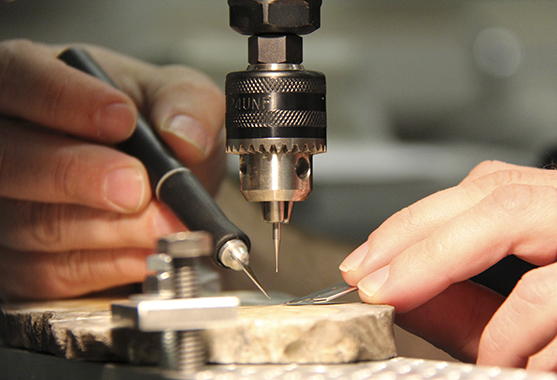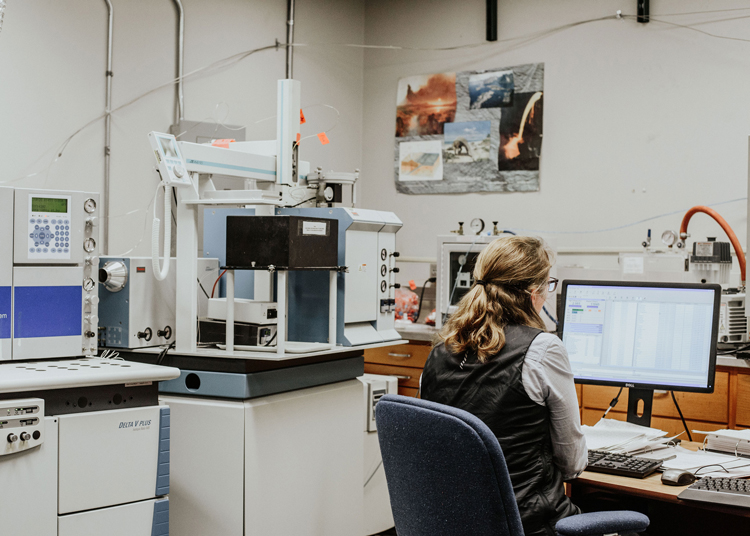Tom Bevill Energy, Mineral, and Materials Science Research Building
 Micromilling and sampling of shell The 145,000-square-foot Bevill Building houses the department’s office space, seminar rooms, and research laboratories. Within those labs, the department is well-equipped for modern quantitative geoscience research. Students learn a wide variety of techniques working alongside faculty on research projects.
Micromilling and sampling of shell The 145,000-square-foot Bevill Building houses the department’s office space, seminar rooms, and research laboratories. Within those labs, the department is well-equipped for modern quantitative geoscience research. Students learn a wide variety of techniques working alongside faculty on research projects.
ANALYTICAL LABORATORIES and INSTRUMENTS
The Alabama Stable Isotope Laboratory (ASIL) houses two gas source isotope ratio mass spectrometers with the following peripheral analyzers:
-
- Gasbench II
- Elemental analyzer
- High-temperature conversion/elemental analyzer
The Geological Elemental Analysis Laboratory (GEAL) features:
-
- Ion chromatograph (IC)
- Inductively coupled plasma optical emission spectrometer (ICP-OES)
- Inductively coupled plasma mass spectrometer (ICP-MS) with Excimer 193 nm laser
- Microwave Digestion System
The Radiogenic Isotope Laboratory (RadIs) features a VG Sector 54 Thermal Ionization Mass Spectrometer (TIMS)
The X-ray Analytical Laboratory features:
-
- A Bruker X-ray diffractometer (XRD)
- A Panalytical X-ray fluorescence spectrometer (XRF)
Additional Instrumentation
- Gas chromatographs (GC)
- High-performance liquid chromatographs (HPLC)
- Ultraviolet and visible spectrophotometer
- Hand-held XRF and LIBS
- Scanning electron microscopes (SEM)
- Duo-chamber Alpha Spectrometer (PIPS)
- High-resolution Gamma Spectrometer (HPGe)
- Liquid Scintillation Counter (LSC)
- Portable radon monitors (RAD7)
- Radium Delayed Coincidence Counters (RaDeCC)
- Malvern laser particle size analyzer
- Magnetic gradiometer
- Ground-penetrating radar
- StrataVisor seismic acquisition system
- LaCoste Romberg gravimeter
- CHIRP subbottom profiler
- Boomer
- Single-channel streamer
- Betsy gun
- Single and three-component geophones
- Sparker
- SuperSting electrical resistivity system (56-electrodes)
- Hand controlled micro-drilling system
- Multiple computer-controlled micro-milling systems
- Truck-mounted geo probe for terrestrial coring
- Aquatic vibra-coring probe
- Seepage meters
- Rock preparation and mineral separation facilities
- Petrographic sectioning and polishing facilities
Smith Hall
Located on the University’s central Quad, Smith Hall is one of the oldest buildings on campus. It houses not only classrooms and lecture halls for the Department of Geological Sciences but also the Alabama Museum of Natural History and the department’s GeoVis Lab, a tool that allows three-dimensional visualization for the study of geological forms and features.
Rodgers Library for Science and Engineering
Two blocks south of the Bevill Building is the Rodgers Library, which offers more than 220,000 books and bound journals plus access to numerous specialized databases and electronic journals. The library is a popular place to study, with a silent zone on the second floor, plus individual and group study rooms that accommodate up to 12 students and feature wireless access and, in some rooms, whiteboards, and smartboards.
The Scholars’ Station serves as a gathering place for students to learn, create, and discover, as well as a place for teaching faculty and students how to use special databases and other electronic resources. For more information about the library, visit lib.ua.edu/libraries/rodgers.
Computers and Software

- Eight CPU, UNIX server with 4TB of disk space
- GeoWall 3-D visualization center
- Two fully equipped computer labs
- Geochemists Workbench (geochemical modeling software)
- PHREEQC (geochemical modeling software)
- AquaChem (geochemical modeling software)
- MODFLOW (groundwater flow modeling software)
- MT3D (groundwater and contaminant transport modeling)
- ArcInfo GIS software
- MATLAB
- IDL
- UNIX utilities including GMT, MB-System
- Landmark graphics software (oil industry standard processing and interpretation software)
- Abaqus (finite element modeling software)
- Kingdom Suite (seismic interpretation software)